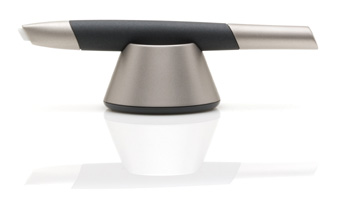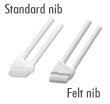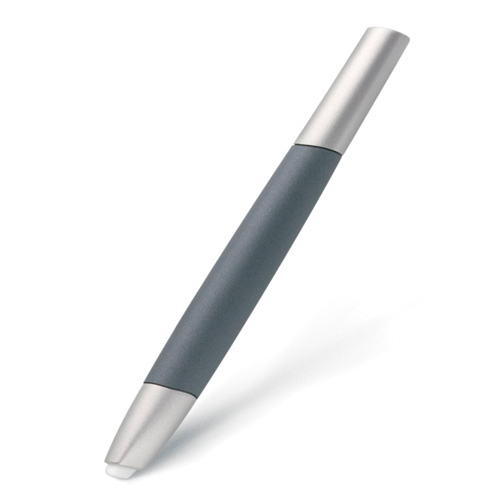Wacom Intuos 3 – 6D Art Pen Review – Part 1
Background and Basics
The Wacom 6D Art Pen was introduced by Wacom along with its Intuos 3 line of pen tablets
and its newest line of Cintiq pen-abled touch displays.
The pen itself added a valuable function to the already generous offering of features of Wacom’s tablets and pens, active rotation.
The pen’s sensors are able to detect the angle in which the pen is rotated.
The Pen & Stand
The pen itself has an elliptical shaped barrel, and is generally thicker than the Intuos 3 pen that ships with the Intuos 3 tablet, and is about an inch shorter.
Unlike the “default” pen, the 6D Art Pen does not include any side button switches or an eraser on the opposite end.
The tip (nib) is shaped like an angled, chisel-tipped marker (appears to be about 30 degrees).
The pen ships with two different types of nibs. One type is made from the familiar white plastic present in the default pen, and the other is a semi-hardened foam/felt that mimics the feel of a brush or marker.
Both types of nib are useful for different purposes and feel very different from each other (more detail on these later).
The pen also ships with a pen stand exactly like the pen stand for the Intuos 3 pen, except the pen does not stand in the pen stand, it lays across the stand for an elegant showcasing for when the pen is not in use.

How it feels to use…
The feel of the pen in hand is very different from the default pen; it is lighter, and the shape fits well in the hand using a grip similar to how one would hold a pen, pencil, or brush.
This shape also helps the user keep track of the rotation orientation of the pen by feel alone. This is especially useful when painting “blindly” on an Intuos 3 tablet where the user is concentrated on the on-screen painting and not the pen and tablet themselves.
Rotating the pen, it is equally comfortable to use in any orientation.
The Digital Painting Experience
Painting with the pen yields a different feel from the default pen.
Pen pressure, while equally sensitive as the default Intuos 3 pen, translates through the chiseled nib very differently.
The feel is very dynamic, especially with the plastic nib. This leads to a greater feeling of control and “naturalness” when painting.
The felt nib simply glides across the surface of the tablet with just enough softness to mimic the feel of painting with a brush.
Dynamic pressure is not translated quite as well with the felt nib as with the plastic one, but in general, it does feel more like a real brush than the plastic nib because of this. The softness of the nib feels like bristles being pressed onto a canvas.

Use of the pen adds a whole new feel of realism when used in conjunction with digital painting software packages that support the rotation feature.
In part 2 of this review series, we’ll dig in and get some digital paint on our hands with Corel Painter X!
